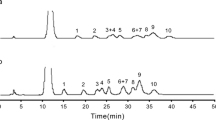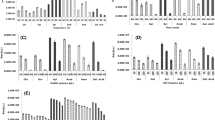Abstract
A rapid and sensitive method was optimized and validated for the separation and quantification of derivatized monosaccharides in polysaccharide from Potentilla anserine L. using 1-naphthyl-3-methyl-5-pyrazolone (NMP) as precolumn derivatization reagent by capillary zone electrophoresis (CZE). On the basis of the optimum conditions, nine NMP-derivatized monosaccharides achieve baseline resolution within 16 min. The developed method has been successfully applied to analyze component monosaccharides of three Potentilla anserine L. samples, which were obtained by gradational precipitation with 50, 70, and 90% aqueous ethanol, respectively. The polysaccharide precipitated from 50% ethanol solvent was composed of fucose, mannose, xylose, glucuronic acid, glucose, rhamnose, galacturonic acid, galactose, arabinose in molar proportion of 1:1.65:1.99:5.08:7.38:8.14:13.05:27.41:39.02; the corresponding molar proportions for polysaccharide obtained from 70% ethanol solvent were 1:1.64:1.65:4.52:13.96:9.13:26.30:10.52:18.00; fucose and galacturonic acid were not found in the polysaccharide precipitated from 90% ethanol solvent, and mannose, xylose, glucuronic acid, glucose, rhamnose, galactose and arabinose were determined with molar proportion of 1:0.87:1.77:2.78:1.69:2.58:2.49. Quantitative recoveries of the component monosaccharides in the polysaccharide were in the range of 93.3–105.1% and the relative standard deviation (RSD) values fell within 3.4–6.3%, respectively. The results demonstrated that the proposed CZE method was precise and sensitive for the analysis of the composition of polysaccharide.



Similar content being viewed by others
References
Tzianabos AO (2000) Polysaccharide immunomodulators as therapeutic agents: structural aspects and biologic function. Clin Microbiol Rev 13:523–533
Yu F, Sheng JC, Xu J, An XX, Hu QH (2007) Antioxidant activities of crude tea polyphenols, polysaccharides and proteins of selenium-enriched tea and regular green tea. Eur Food Res Technol 225:843–848
Gao Y, Zhou S, Jiang WQ, Huang M, Dai X (2003) Effects of ganopoly (A Ganoderma lucidum polysaccharide extract) on the immune functions in advanced-stage cancer patients. Immunol Invest 3:201–215
Chen HX, Zhang M, Qu ZS, Xie BJ (2008) Antioxidant activities of different fractions of polysaccharide conjugates from green tea (Camellia sinensis). Food Chem 106:559–563
Han SB, Yoon YD, Ahn HJ, Lee HS, Lee CW, Yoon WK, Park SK, Kim HM (2003) Toll-like receptor-mediated activation of B cells and macrophages by polysaccharide isolated from cell culture of Acanthopanax senticosus. Int Immunopharmacol 3:1301–1312
Ando I, Tsukumo Y, Wakabayashi T, Akashi S, Miyake K, Kataoka T, Nagai K (2002) Safflower polysaccharides activate the transcription factor NF-κB via Toll-like receptor 4 and induce cytokine production by macrophages. Int Immunopharmacol 2:1155–1162
Shimizu N, Tomoda M, Kanari M, Gonda R (1991) An acidic polysaccharide having activity on the recticuloendothelial system from the root of Astragalus mongholicus. Chem Pharm Bull 39:2969–2972
Cui R, He JC, Wang B, Zhang F, Chen GY, Yin S, Shen H (2003) Suppressive effect of Astragalus membranaceus Bunge on chemical hepatocarcinogenesis in rats. Cancer Chemother Pharmacol 51:75–80
Jin Y, Zhang LN, Zhang M, Chen L, Cheung PCK, Qi VEC, Lin Y (2003) Antitumor activities of heteropolysaccharides of Poria cocos mycelia from different strains and culture media. Carbohydr Res 338:1517–1521
The Academy of JiangXi New Medicine (1997) Traditional Chinese drugs dictionary. Shanghai, China
Wu ZY (1990) Xinhua herbal scheme. Shanghai, China
Li XY, Yuan HL, Liu YB, Cai GM, Zhang L, Che H (2004) Analysis of benzene series residues in Potentilla ansterina L. extraction by headspace-GC. Lishizhen Med Maieria Med Res 15:484–485
Zhao YL, Cai GM, Hong X, Shan LM, Xiao XH (2008) Anti-hepatitis B virus activities of triterpenoid saponin compound from Potentilla anserine L. Phytomedicine 15:253–258
Zhang XQ, Zhao YL, Shan LM, Wei ZM, Cai GM (2004) Study on protective mechanism of JMS on chemical liver injury. Pharm J Chin People’s Lib Army 20(4):259–261
Suzuki S, Tanaka R, Takada K, Inoue N, Yashima Y, Honda A, Honda S (2001) Analysis of sialo-N-glycans in glycoproteins as 1-phenyl-3-methyl-5-pyrazolone derivatives by capillary electrophoresis. J chromatogr A 910:319–329
Sun ZW, Liu LJ, Hu BJ, Sheng X, Wang XY, Suo YR, You JM (2008) Preparation of 1-(2-naphthyl)-3-methyl-5-pyrazolone as pre-column derivatization reagent for separation and determination of saccharides using HPLC–MS. Chin J Chromatogr 26:200–205
You JM, Sheng X, Ding CX, Sun ZW, Suo YR, Wang HL, Li YL (2008) Detection of carbohydrates using new labeling reagent 1-(2-naphthyl)-3-methyl-5-pyrazolone by capillary zone electrophoresis with absorbance (UV). Anal Chim Acta 609:66–75
Sheng X, Ding CX, Liu LJ, Suo YR, Sun ZW, You JM (2008) Separation of derivatized carbohydrates by capillary zone electrophoresis. Chin J Anal Chem 36(3):280–284
Lin X, Wang ZF, Huang LJ, Bai Q, Jia F (2006) An improved PMP derivatization method for analyzing monosaccharide composition. Chem J Chin Univ 27:1456–1458
Ming YF, Sun YX, You JM (2003) Separation of amino acids by capillary zone electrophoresis using 9-(2-Carbazole) ethyl chloroformate as derivatization agent. Chem Res 14:9–12
Acknowledgments
This work was supported by the National Science Foundation under Grants # 20075016 and 30370218.
Author information
Authors and Affiliations
Corresponding author
Rights and permissions
About this article
Cite this article
Xia, L., Sun, Z.W., Li, G.L. et al. A sensitive analytical method for the component monosaccharides of the polysaccharides from a Tibetan herb Potentilla anserine L. by capillary zone electrophoresis with UV detector. Eur Food Res Technol 230, 715–722 (2010). https://doi.org/10.1007/s00217-009-1212-z
Received:
Revised:
Accepted:
Published:
Issue Date:
DOI: https://doi.org/10.1007/s00217-009-1212-z




